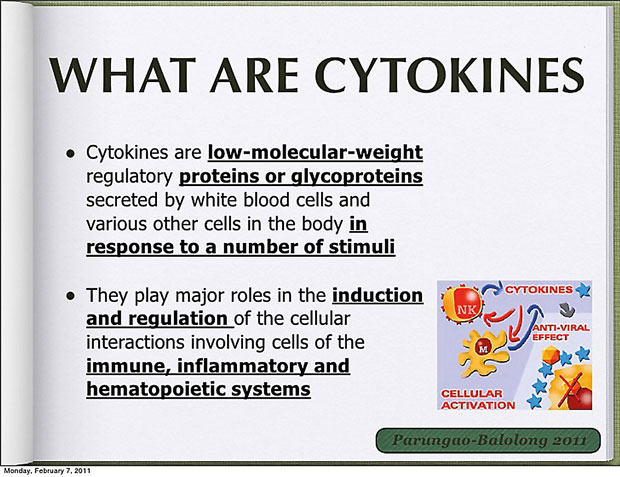01 Sep 2017 - {{hitsCtrl.values.hits}}

Ever fallen down and hit yourself somewhere hard, which later resulted in warmth, redness and swelling of the particular side with pain on top of that? Ever got a head injury and thought why you feel a lump on the scalp where it feels tender when touched?
 These are all signs and symptoms of a protective mechanism in the body known as inflammation. This process will respond quickly to a trauma by dilating your blood vessels and increasing the perfusion to the site of injury. This ensures quick recovery with many more cascades of event, triggered by what are called CYTOKINES.
These are all signs and symptoms of a protective mechanism in the body known as inflammation. This process will respond quickly to a trauma by dilating your blood vessels and increasing the perfusion to the site of injury. This ensures quick recovery with many more cascades of event, triggered by what are called CYTOKINES.
These are a set of broad and loose yet small proteins which are important in cell signaling, cellular interactions and inter-cellular communication. In fact, their main function is to regulate the behaviour of cells around them by maintaining an autocrine signaling system, a paracrine signalling system and an endocrine signalling system by means of activities similar to that of immunomodulating agents.
Even though the exact line of demarcation between cytokines and hormones are still under research, there are several similarities between them.
Commonest Cytokines in the human body include chemokines, interferons, interleukins, lymphokines, and Tumour Necrosis Factors (TNF) which are produced by a wide variety of cells such as macrophages, B lymphocytes, T lymphocytes, mast cells, endothelial cells, fibroblasts and stromal cells.

Acting through specific receptors, Cytokines carry out a significant role in immunological functions by maintaining a balance between humoral and cell-based immune responses. They also help in modulating the maturation, growth, and responsiveness of various cell populations while working on enhancing or inhibiting the action of several other different types of cytokines as well.
Q What is inflammation?
This is a mechanism by which our body attempts to maintain self-protection through removing harmful stimuli with already damaged cells, irritants and other causative pathogens, thereby beginning the healing process.
QHow do cytokines involve in inflammation?
The specific group of cytokines known as anti-inflammatory cytokines are defined as a series of immunoregulatory molecules which regulate the pro-inflammatory cytokine response following an injury. These specific molecules which function hand in hand with various other cytokine inhibitors and soluble cytokine receptors will carry out an effective human immune response towards harmful stimuli. Their physiological role in inflammation as well as the pathological role in systemic inflammatory cascades are highly important for a well-functioning immunity system.

Major types of anti-inflammatory cytokines
Out of these, IL-1, TNF-α, and IL-18 also act as inhibitors for pro-inflammatory cytokines mentioned above, by some sort of a dual function.
Additionally, IL-10 is the most important cytokine out of these, which own potent anti-inflammatory properties capable of repressing the expression of inflammatory cytokines like TNF-α, IL-6 and IL-1 with the help of activated macrophages.
At the very moment a trauma to the body occurs, Tumor Necrosis Factor-alpha (TNF-α) will be the first cytokine to be produced by activated macrophages and monocytes.
These will eventually dilate the nearby capillaries in order to bring circulating white blood cells to the site of infection as soon as possible. Within few seconds, a cascade of signals will get transmitted all over the body, resulting in the death of already damaged cells which will in turn prevent the spread of infection.
The four characteristic features of inflammation including erythema, warmth, swelling and pain are known to be a set of prominent responses to TNF-α which occurs as a result of increased blood flow, increased capillary permeability, rapid influx of phagocytic cells and extensive tissue damage.
Constriction of the capillaries which carry blood away from the infected area, will result in an engorgement of the capillary network giving rise to a redness and increased temperature in the site. Furthermore, as a result of this high permeability, fluids which have a higher protein concentration compared to that of normal body fluids will move in to the extra vascular compartment, causing swelling.
Moreover, Cytokines will further act to enhance the effectiveness of inflammatory response by attracting macrophages to the infected area whereas Neutrophils mark the first most entry to the particular site.
On a concluding thought, Cytokines which are produced effectively by infected cells, dendritic cells and macrophages as described above are known to play a huge role in responding to infections and trauma occurring to the body by the protective mechanism called INFLAMMATION.
23 Dec 2024 2 hours ago
23 Dec 2024 3 hours ago
23 Dec 2024 6 hours ago
23 Dec 2024 7 hours ago